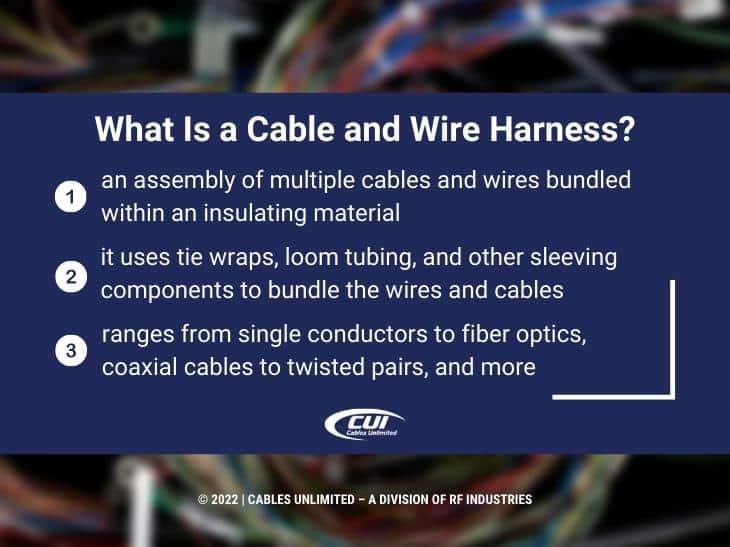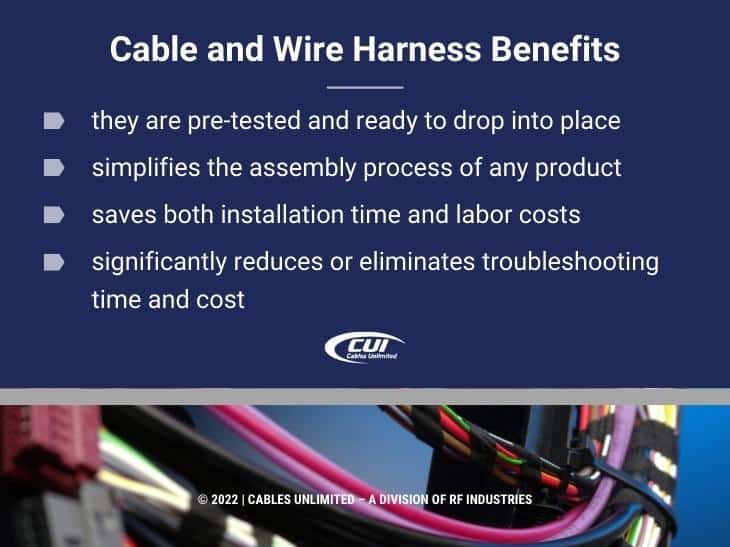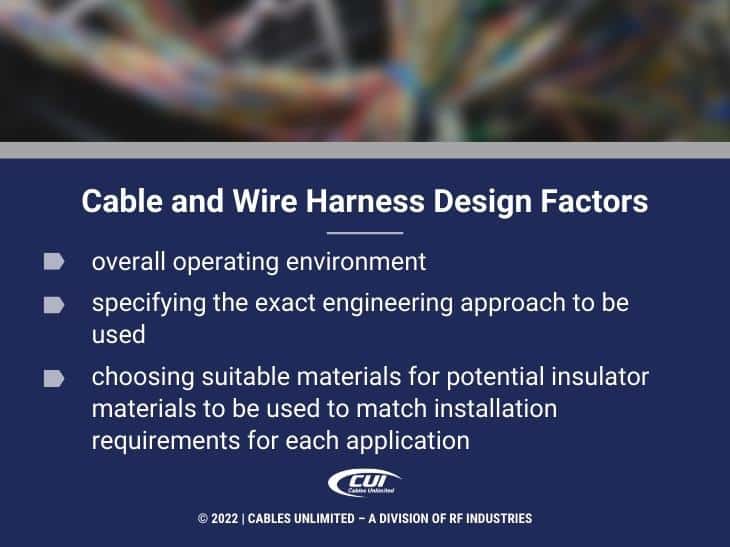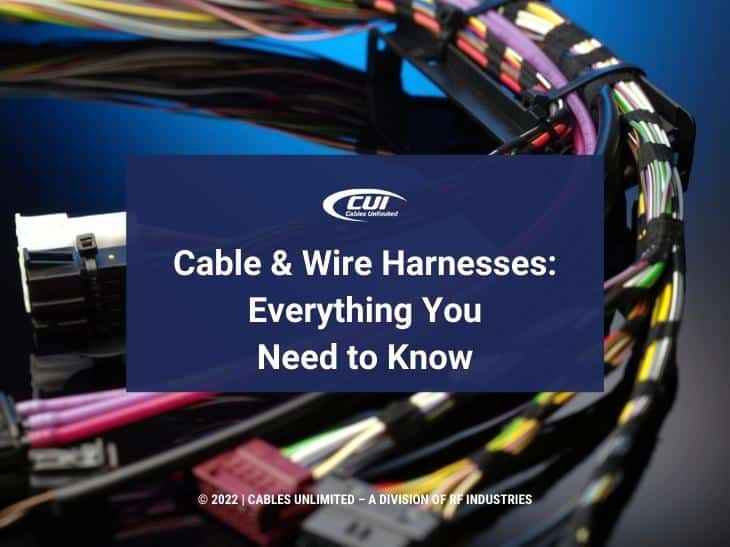TechNavio predicts that the global wire harness market will grow by over $35 billion from 2022 to 2026 with a compound annual growth rate (CAGR) of 5.7%. The factors behind this growth include the growing demand from nearly every product segment that uses electronics in one form or another. This article defines cable and wire harnesses, examines their many benefits, explores their design factors, and digs deeper into their applications.

What Is a Cable and Wire Harness?
A cable and wire harness is an assembly of multiple cables and wires bundled within an insulating material. It uses tie wraps, loom tubing, and other sleeving components to bundle the wires and cables. The cables and wires range from single conductors to fiber optics, coaxial cables to twisted pairs, and more.
Since the harness is bound together, it provides a safe routing pattern. It further simplifies the wiring interconnections by delivering an all-in-one integrated drop-in installation across multiple connection points.
Note that wire harnesses and cable assemblies are often confused with one another. A cable assembly typically has two ends. Plus, the cable assembly is usually encased within a single tube of heavy-duty material. A wire harness has multiple breakouts running in many directions, with several terminations on each breakout.
If you’re interested in cable assemblies, see our article Wire Harnesses and Cable Assemblies — What’s the Difference? for more information.

Cable and Wire Harness Benefits
The significant benefit of cable and wire harnesses is that they are pre-tested and ready to drop into place. This dramatically simplifies the assembly process of any product, whereas the alternative is to manually run wires and cables one at a time throughout the device. This saves both installation time and labor costs. It also can significantly reduce or eliminate troubleshooting time and cost when trying to find the errors from a faulty point-to-point installation of multiple cables and wires.
Once installed, the benefits continue. The sheath and careful pre-planned routing protect the cables and wires from abrasion and exposure to hazards such as moving parts, moisture, or chemicals. The connectors, bundled cables, wires, and overall cable routing, save space. Plus, consistent routing and documentation greatly simplify the work of a technician in either troubleshooting or upgrading the system with new components.

Cable and Wire Harness Design Factors
There are quite a few factors to consider when designing cable and wire harnesses. They start with the overall operating environment. That includes indoor or outdoor, operating temperature range, voltage and current levels, exposure to chemicals and moisture, operating flex requirements, and applicable safety and environmental regulations.
Once those factors have been determined, the specific engineering approach must be specified. That starts with the required connectors, shielding, and binding materials such as wire ties, lacing, heat shrink tubing, and insulation. On top of that comes labeling, ink stamping, tagging, and even custom colors.
Then there’s an almost staggering number of potential insulator materials that can be used to match the installation requirements. Here’s a starting list of acronyms: EPDM, PVC, SR-PVC, PE, LPDE, HDPE, TPE, TPR, PU, PP, FEP, TFE, PTFE, ETFE, PVDF, ECTFE, XLPE, and IRR/PVC. Choosing the suitable materials for each application requires considerable expertise and experience, something the engineers at Cables-Unlimited have built over many years in providing superior custom cable and wire harnesses.

Cable and Wire Harness Applications
As with the list of insulator acronyms above, the list of applications is just as long, if not longer. The Wire Harness Market Report from Transparency Market Research lists the following applications for cable and wire harnesses.
- Automotive
- Trucks & Buses
- Motorbikes & Scooters
- Fleet Truck Cargo Vans
- Electric Vehicles
- Recreational Vehicles
- Marine and Marine Engines
- Aerospace & Defense Applications
- Military Machines
- Gaming & Amusements
- Electronic & Casino Gaming Machines
- Amusement Vending Machines
- Crane & Gift Gaming Machines
- Medical Equipment & Devices
- Commercial Refrigeration & Food Machines
- Consumer Technology & Durables
- Computing Devices
- Networking & Communication
- Appliances
- Lawn & Garden Equipment
- Fitness Equipment & Machines
- Power & Energy Equipment
- Power Generation Equipment
- HVAC Equipment
- Solar Panels
- Agricultural Equipment
- Automation Equipment & Robotics
- Construction Equipment
- Material Handling Equipment
- Fuel Dispenser System
- Production Machinery
- Floor Scrubbers
- Electric Motors
- Mechanical Lifts
- Elevators & Escalator
- Batteries
For further information on applications, see our article Wire Harnesses: Industrial, Robotics, Commercial Product Use Cases.
We Can Help with Your Cable and Wire Harness Selection
If your cable and wire harness requirements are already specified and ready for a quote for your current projects, we are prepared to meet your deadlines and pricing targets. Our extensive in-house services and advanced manufacturing capabilities are in place to meet your requirements.
But Cables-Unlimited offers much more than state-of-the-art manufacturing – our dedicated team is also known for going to great lengths to meet the needs of our customers, including working round-the-clock to meet tight turnaround time requirements.
Our sales representatives are standing by to assist you with product questions and quotes Monday – Friday, 8:00 am to 5:00 pm Eastern. You can also send us an email or complete our contact form, and we’ll get right back to you.




